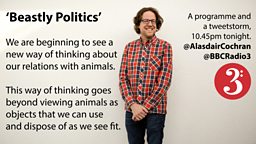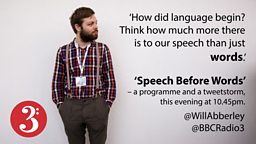New Generation Thinkers 2014 - Tweetstorms
The Radio 3 New Generation Thinkers 2014 recently gave talks in front of the audience at Sage Gateshead at the 2014 Free Thinking Festival of ideas. This year's festival theme was 'the limits of knowledge' and each New Generation Thinker chose very different topics and specific areas of their own research to base their talk around.
Radio 3 broadcast the talks as a series called 'The Free Thinking Essay'. To coincide with these broadcasts, we fired out a tweetstorm from the @BBCRadio3 twitter account every evening based on the theme of that night's talk. A tweetstorm is a string of tweets, all based on the same topic, debate or argument, rapidly sent out in quick succession to create a concise flow of ideas, aiming to inspire further thoughts and discussion from the reader.
Links to each programme are included below so that you can listen to all of the talks.
Tiffany Watt-Smith - 'The Human Copying Machine'

Click here to listen to: 'The Human Copying Machine'.
1/12 Do you yawn when someone else does? Or inadvertently mimic other people’s accents?
Do you yawn when someone else does? Or inadvertently mimic other people's accents? Today's neuroscientists say 'mirror neurons' are to blame. But long before MRI scanners, Victorian psychologists also believed we were hard-wired to imitate.
2/12 Today’s neuroscientists say ‘mirror neurons’ are to blame. But long before fMRI scanners, Victorian psychologists also believed...
3/12 we were hard-wired to imitate. They started off thinking it was a peculiarity - seen only among the 'lower races' and women in asylums.
4/12 In the 1880s, a new generation of scientific psychologists started to realise they imitated one another too.
5/12 Mimicry became so important that the American psychologist described the brain as a 'repeating organ'...
6/12 and the body as a 'copying machine'.
7/12 But what is most intriguing about this history is how these scientists turned to the world of Victorian theatre to create knowledge..
8/12 of the human mind and body. They visited music halls and experimented with actors - sometimes performing themselves.
9/12 In our culture there are hierarchies of knowledge: the sciences at the top, and drama somewhere near the bottom.
10/12 The history of mirror neurons shows us that scientific knowledge is not created in a vacuum.
11/12 In the nineteenth century, theatre was a vital part of laboratory life.
12/12 And if you look close enough, you might find that it still is.
Tom Charlton - 'Scold the Front Page'

Click here to listen to: 'Scold the Front Page'.
1/9 Who censors what? Why? How? Debates over media regulation continue to rage today.
Who censors what, how, and why? Is this a job for the government, or for journalists themselves?
2/9 Advocates of press freedom _and_ those who favour tighter controls both misunderstand and misrepresent the history of press regulation.
3/9 Modern commentary on the seventeenth century is dominated by the Licensing Act of 1662.
4/9 This established by statute a system of prepublication vetting of printed material.
5/9 But the execution of the printer John Twyn, in 1664, can tell us much more about the way seventeenth-century censorship worked...
6/9 ..and how censorship continues to work. Twyn was executed, not under the licensing act, but for treason.
7/9 Attempts to regulate the press, from the Licensing Act to today's Royal Charter, must be understood in the context of other measures.
8/9 ..Such as libel laws, antiterrorism legislation, or the Regulation of Investigatory Powers Act.
9/9 Such a range of measures control both what we read, and how we read it.
Sophie Coulombeau - 'Is Marriage an Identity Crisis?'

Click here to listen to: 'Is Marriage an Identity Crisis?'.
1/10 Women are often urged to consider 'tradition' when deciding whether to take their husband's name, but how did this very English custom
Women are often urged to consider 'tradition' when deciding whether to take their husband's name, but where did that idea begin?
2/10 begin? It originated in the medieval period, probably as the linguistic symbol of coverture, a principle that meant on marriage a woman
3/10 ceased legally to exist. But there have always been women who defied criticism to buck the trend and keep their maiden names.
4/10 During the Georgian period, wealthy and powerful British women petitioned for Royal Licences or Acts of Parliament to compel men to
5/10 take *their* names, a controversial fashion that ignited debate around literary London.
6/10 Over the nineteenth century, the restrictions of coverture were abolished in Britain, but its symbol lived on and had spread to many
7/10 other countries too. In the USA, the early twentieth-century feminist society the 'Lucy Stoners' challenged government edicts that
8/10 denied a woman the right to use the name she chose. This right was conclusively acknowledged only in the 1970s. The debate rages on.
9/10 Every woman in Britain and the USA can now make this choice for herself.
10/10 Let's remember the women throughout history who made that possible.
Daisy Hay - 'Disraeli the Romantic'

Click here to listen to: 'Disraeli the Romantic'.
1/10 Politicians talking about their private lives are a commonplace of our age.
Daisy Hay explores the way in which Disraeli invented the modern politician as a man - or woman - of feeling, and asks whether the image he projected as an emotionally in-touch everyman stemmed from fact or fiction?
2/10 However, long before it became obligatory for aspiring statesmen and women to be photographed unloading dishwashers
3/10 and eating sandwiches, Benjamin Disraeli spun a public fantasy about his private life in order to win votes.
4/10 Daisy Hay from Exeter University explores the way in which Disraeli invented the modern politician as a man – or woman – of feeling,
5/10 and asks whether the image he projected as an emotionally in-touch everyman stemmed from fact or fiction?
6/10 She also tells the story of the Disraelis' marriage, in which Disraeli and his wife Mary Anne cast themselves as hero and heroine of
7/10 a grand romance. They did so initially in order to paper over the cracks of an inauthentic, contingent relationship,
8/10 and eventually because, in spite of everything, they made their strange romance come true.
9/10 Disraeli the Romantic traces a marital journey from coldness to autumnal sunshine,
10/10 illuminating the shift that journey produced in British politics along the way.
Alun Withey - 'Beards and Whiskers'

Click here to listen to: 'Beards and Whiskers'.
1/12 We tend to think of beards and facial hair as something quirky and mundane. How can they possibly tell us anything about the past?
Jeremy Paxman made headlines when he grew a beard, taking his place alongside actors Jake Gyllenhaal and George Clooney, Eurovision winner Conchita Wurst, folk-rocker Marcus Mumford and hipster model Johnny Harrington. Pogonotomy - or the art of shaving - is about more than fashion.
2/12 But beards are actually central to a wide range of themes across history.
3/12 Beard styles tell us a lot about how men view themselves, but also what any given society regards as an 'ideal' man.
4/12 Emulation of bearded heroes, for example, has been one reason for the popularity of facial hair through the centuries.
5/12 Shaving technologies reveal the story of personal grooming and the development of razors.
6/12 The current trend for beards has cost the razor industry over 72 million pounds.
7/12 In the 1770s though, new steel razors were the 'must have' accessory of the day!
8/12 Over the past 500 years or so, every age has its own recognisable style of facial hair.
9/12 Georgians were clean shaven, while Victorian men sported mighty examples of facial topiary.
10/12 Soldiers in the British Army were required by regulation to wear a moustache until 1916.
11/12 So, far from being a historical irrelevance, beards are actually linked to everything from technology
12/12 to culture, gender and sexuality. Our faces tell a story though time.
Alasdair Cochrane - 'Beastly Politics'

Click here to listen to: 'Beastly Politics'.
1/10 We are beginning to see a new way of thinking about our relations with animals.
Is man the only political beast? Can other animals be regarded as members of our democratic communities, with rights to political consideration, representation or even participation?
2/10 This way of thinking goes beyond viewing animals as objects that we can use and dispose of as we see fit.
3/10 It also goes beyond seeing animals as simply of moral concern: creatures that good people ought to be kind to.
4/10 Instead it sees animals as members of our political communities; as individuals entitled to recognition
5/10 and representation within our political institutions.
6/10 Germany, Switzerland, India and Brazil have all provided constitutional protection to animals.
7/10 The Swiss canton of Zurich has provided animals with their own legal advocate.
8/10 Some UK police constabularies are even providing state pensions for their retired dogs.
9/10 I argue that these are the first initial steps of a new more 'beastly' form of politics which should be welcomed,
10/10 strengthened and extended.
Will Abberley - 'Speech Before Words'

Click here to listen to: 'Speech Before Words'.
1/10 We are beginning to see a new way of thinking about our relations with animals.
Where did language come from? It's often been described as the fundamental barrier between humans and animals. However, many scientists now believe speech evolved gradually from animal communication.
2/10 This way of thinking goes beyond viewing animals as objects that we can use and dispose of as we see fit.
3/10 It also goes beyond seeing animals as simply of moral concern: creatures that good people ought to be kind to.
4/10 Instead it sees animals as members of our political communities; as individuals entitled to recognition
5/10 and representation within our political institutions.
6/10 Germany, Switzerland, India and Brazil have all provided constitutional protection to animals.
7/10 The Swiss canton of Zurich has provided animals with their own legal advocate.
8/10 Some UK police constabularies are even providing state pensions for their retired dogs.
9/10 I argue that these are the first initial steps of a new more ‘beastly’ form of politics which should be welcomed,
10/10 strengthened and extended.
Naomi Paxton - 'A Theatre of Their Own'

Click here to listen to: 'A Theatre of Their Own'.
1/12 The Actresses' Franchise League had been producing suffrage plays since 1908 as part of their work for votes for women.
Women's Theatre Week in London in December 1913 marked the beginning of a project that the Actresses' Franchise League hoped would change their industry for the better.
2/12 Audiences didn’t have to go to a theatre to see a suffrage play, they were performed in a variety of spaces–including skating rinks...
3/12 ...restaurants and town halls. This new political theatre had success and potential.
4/12 It responded directly to and was inspired by the lives of working people.
5/12 It gave Edwardian actresses a glimpse into a different kind of theatre, one in which they could fully take part.
6/12 In 1913 they started a new project, the Woman’s Theatre. They dreamed of an industry in which women could...
7/12 have as much chance to act, write, produce and manage as their male counterparts.
8/12 Similar ideas were springing up in Europe and America, and they reimagined the theatre building.
9/12 The first season of the Woman’s Theatre went well, but the next was delayed because of WW1.
10/12 There is still not equality of opportunity for women in theatre. Why?
11/12 How might the Woman’s Theatre have changed our interactions with theatre today?
12/12 The Woman’s Theatre didn’t want to exclude men, but to include women by design. It’s still an inspirational idea.
Preti Taneja - 'Shakespeare and India'

Click here to listen to: 'Shakespeare and India'.
1/10 In India Narenda Modi’s new government is championing the use of Hindi over English and other Indian languages in public life...
India's new prime minister, Narendra Modi, makes public speeches in Hindi, continuing his party's long campaign to reduce the cultural significance of English. Opponents argue that Hindi is the language of the Hindu religion, while English, whatever its colonial associations, has crossed the nation's often violent religious and cultural divides.
2/10 ...reopening age-old debates and causing reactions across the country.
3/10 Some think he is decolonising minds more used to seeing English as a language of civilisation and aspiration:...
4/10 ...others that he is promoting an ideology of Hindi-Hindu-Hindustan.
5/10 But there is a language that challenges both sides of the argument: gibberish.
6/10 Shakespeare’s works came to India as part of the Empire’s colonising mission...
7/10 ...but the plays use gibberish to subvert state power and speak a more profound truth.
8/10 Let's explore this resonant nonsense in Shakespeare, in translations of his works on the Indian stage...
9/10 ...and in literature including by the seminal Urdu writer Sadaat Hasan Manto.
10/10 Perhaps gibberish is one of the most significant instruments for political and spiritual resistance that a person can use.
Joanna Cohen - 'The Spin Doctors of 19th-Century America'

Click here to listen to: 'The Spin Doctors of 19th-Century America'.
1/11 A modern day truism for politicians seems to be: let the public into your private life and they will connect with you.
In the age of spin, few people believe that they can actually know, let alone trust, a politician. But such public cynicism was not always our default attitude. Embracing the emerging sciences of the age, 19th-century Americans thought they might be able to combine physiognomy (the science of reading faces) and the techniques of photography to uncover the true characters of leaders and statesmen.
2/11 You’ll win public trust and support. Surprisingly this is not just a doctrine of the age of spin...
3/11 In the 19th-Century Americans tried to uncover the inner lives of their leaders by scrutinizing their faces.
4/11 Using photography and the science of physiognomy...
5/11 American voters thought they could truly understand their politicians’ characters and discern their worth.
6/11 Ambitious politicians cashed in on the public’s fascination with personal character.
7/11 President Lincoln distributed cartes-de-visites of his face to potential supporters, hoping to win their approval.
8/11 He worked to make widespread connections with his voters through these new technologies.
9/11 But if technology produces a kind of political intimacy, then what has this trend done to modern day politics?
10/11 What do Facebook and Twitter really show us?...
11/11 ...And is what we know about our politicians today really useful?
